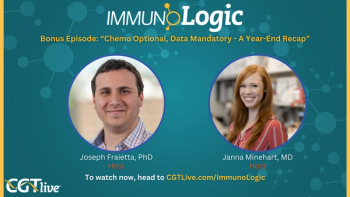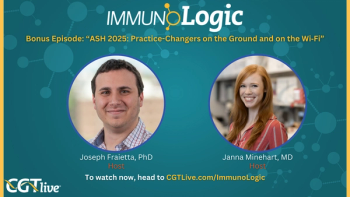
NurOwn Cell Therapy for ALS Will Have Its Day in Front of FDA AdComm After All
In November 2022, BrainStorm received a refusal to file letter from the FDA for the biologics license application of NurOwn.
This article originally appeared on our sister site,
After months of discussion with the FDA, BrainStorm Cell Therapeutics has announced the agency will hold an advisory committee meeting hearing to discuss the company’s investigational stromal cell therapy, a potential treatment for patients with amyotrophic lateral sclerosis (ALS).1
To expedite this process, BrainStorm requested that the Center for Biologics Evaluation and Research (CBER) utilize the FDA’s File Over Protest procedure. In November 2022, BrainStorm received a refusal to file letter from the FDA for the biologics license application (BLA) of NurOwn; however, the company has now filed an amendment to the BLA that responded to most of the outstanding questions the FDA had posed.
"The FDA provided us with more than one path to an Advisory Committee Meeting for NurOwn. Our goal has always been to make NurOwn available to people living with ALS as quickly as possible, therefore we chose the File Over Protest pathway since this offered the fastest path to an ADCOM and regulatory decision relative to other pathways provided by FDA," Chaim Lebovits, president and chief executive officer, BrainStorm, said in a statement.1 "The ALS community needs additional treatment options now, and we firmly believe our data support regulatory approval of NurOwn. We are grateful to the FDA for the opportunity to have the clinical evidence supporting NurOwn reviewed."
NurOwn, or autologous mesenchymal stromal cells secreting neurotrophic factors cells (MSC-NTF), had its BLA based on a phase 3 study (NCT03280056) in which the agent originally failed to meet its primary end point, but continued to significant effects on less severe forms of ALS. In total, 33% and 28% of those on NurOwn and placebo, respectively, met the primary end point of change in disease progression of at least 1.25 points on ALS Functional Rating Scale (ALSFRS-R).2
In March 2021, following a review of the phase 3 data, the FDA concluded that the current level of data did not cross the threshold of substantial evidence to support a BLA. More than a year later, in August 2022,
In post hoc analyses, it was originally reported that the least square (LS) mean for placebo (range, –4.32 to –5.81) exhibited far less spread in the LS mean change than those in the MSC-NFT group (range, –1.58 to –4.61). These LS means were corrected for both the MSC-NTF (range, –1.39 to –4.82) and placebo (range, –4.24 to –5.98), but still indicated that placebo-treated patients lost 4 to 5 points on average in 28 weeks across baseline thresholds while those on active treatment lost less function at higher compared with lower baseline levels.
In the same section, the updated results showed that MSC-NTF-treated participants lost, on average, 2 points of function less compared with placebo, which was maintained or increased through the prespecified threshold of ALSFRS-R scores of 35, a difference which was nominally statistically significant (P <.05) for all thresholds greater than 26 up to 35 and an exact P value of 0.050 for the threshold of 35 and above. Changes in ALSFRS-R over time showed how quickly the MSC-NTF diverged from placebo, across baseline thresholds, using the prespecified MMRM model and the post hoc sensitivity analysis that accounted for death and missing data.
"Securing an Advisory Committee Meeting represents an important step towards our goal of making NurOwn broadly available to ALS patients in urgent need of new, effective therapies," Stacy Lindborg, PhD, co-chief executive officer, BrainStorm, said in a statement.1 "The meeting will provide an open forum for BrainStorm and the FDA, together with medical experts, statisticians, and the ALS community, to thoughtfully review all available evidence supporting NurOwn. We remain confident in NurOwn and we are committed to doing everything in our power to make the product available quickly to people living with ALS. We look forward to a robust scientific discussion."
At the 2022 Annual NEALS Meeting,
The primary end point was a responder analysis defined as the percentage of participants with at least a 1.25 points/month improvement on ALSFRS-R after treatment with NurOwn. When applying the TST and ILT, 34.7% and 35.4% of NurOwn-treated patients, respectively, achieved the primary end point, compared with 20.5% and 22.5% of those on placebo (P = .053 and P = .035). The secondary end point—average change from baseline to week 28 in ALSFRS-R—also continued to favor active treatment. After utilizing TST and ILT, patients showed average changes of –4.82 and –4.6, respectively, compared with changes of –5.98 and –6.08 for those on placebo (P = .250 and P = .125).
REFERENCES
1. BrainStorm Cell Therapeutics announces FDA Advisory Committee meeting to review biologics license application for NurOwn for the treatment of ALS. March 27, 2023. Accessed March 27, 2023.
2. Cudkowicz ME, Lindborg SR, Goyal NA, et al. A randomized placebo-controlled phase 3 study of mesenchymal stem cells induced to secrete high levels of neurotrophic factors in amyotrophic lateral sclerosis. Muscle & Nerve. Published online December 10, 2021. doi:10.1002/mus.27472
3. BrainStorm Cell Therapeutics announces second quarter 2022 financial results and provides a corporate update. News release. BrainStorm Cell Therapeutics. August 15, 2022. Accessed March 24, 2023. https://ir.brainstorm-cell.com/2022-08-15-BrainStorm-Cell-Therapeutics-Announces-Second-Quarter-2022-Financial-Results-and-Provides-a-Corporate-Updat
4. Erratum. Muscle & Nerve. Published online August 12, 2022. doi:10.1002/mus.27697
5. Cudkowicz ME, Lindborg SR, Goyal NA, et al. Further analysis of NurOwn phase 3 data based on baseline ALSFRS-R status clarifies treatment outcomes. Presented at: 2022 Annual NEALS Meeting; November 1-3; Clearwater Beach, FL. Abstract 107
Newsletter
Stay at the forefront of cutting-edge science with CGT—your direct line to expert insights, breakthrough data, and real-time coverage of the latest advancements in cell and gene therapy.





































